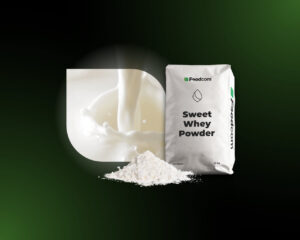- In Europe, cream and milk concentrate prices show considerable volatility related to seasonal changes in weather and local production conditions.
- A decline in butter prices in Europe, with a forecast increase in the coming quarter due to seasonal changes.
- In Ireland, heavy rainfall has contributed to a feed crisis and a significant drop in milk production, which has put pressure on local farmers and their businesses.
Hello Partners!
Welcome back to our Newsletter!
We follow the dynamic changes in the dairy market and monitor the impact of seasonal, economic and environmental factors on markets from Australia to Europe. In this issue, we focus on the latest trends in dairy production and consumption and highlight the challenges producers face as climate and market conditions change. We provide you with key information to help you make informed decisions in an increasingly complex dairy market.
Let’s take a look at what else is happening in the dairy market!
Products
Skimmed Milk Powder
The SMP for the feed market is active, with spot prices reported at 2275 EUR/MT. Prices for future deliveries are expected to be higher, signaling a tight outlook. Trading volume remains low, suggesting cautious buyer behavior amidst pricing uncertainties.
The food-grade SMP market is seeing a broader price range between 2300 and 2400 EUR/MT, with expectations for higher future prices due to increasing demand as we move into the second half of 2024.
Cheese
The Cheese markets remain stable and show no significant price fluctuations. This stability indicates a balanced market with stable supply and demand dynamics. However, we are also seeing an increase in requests for Cagliata and Cheddar throughout Europe.
Fats
The Butter market has seen a decrease in prices, now trading between 5700 and 5800 EUR/MT. However, forecasts for the third quarter anticipate higher prices, likely in response to seasonal demand shifts and changes in milk fat availability.
Liquids
Cream prices have experienced significant volatility, currently positioned between 6500 and 6600 EUR/MT FCA, with some early-week mentions as low as 6300 EUR/MT. In France, prices are maintaining a higher bracket of 6800 to 6900 EUR/MT, attributed to French origin. Market analysts suggest that weather conditions, particularly temperature fluctuations, are a predictive factor for cream prices, which have recently dipped following unseasonably cool temperatures and snow in some EU areas.
Skimmed Milk Concentrate prices in Germany are declining, with current rates ranging from 1300 to 1400 EUR/MT FCA. In the Netherlands, delivered prices are holding steady at around 1350 EUR/MT, and in France around 1300 EUR/MT.
Milk intake in Germany is approaching its peak season, while French intake has likely surpassed its peak. Irish milk production lags significantly, with estimates showing a 10% to 15% decrease compared to typical levels. The overall EU milk supply could fluctuate considerably if weather conditions shift, potentially impacting production negatively due to poor silage quality caused by wet conditions.
Whey powders
The market for SWP for feed, delivered in the Netherlands (DAP NL), is reporting a price range around 640 EUR/MT for the May-June period. This pricing reflects a relatively quiet trading environment with not much activity noted.
In the dairy commodity sector, Sweet Whey Concentrate prices are currently hovering between 300 and 400 EUR/MT FCA. The market witnessed a temporary drop to 100 EUR/MT due to a plant shutdown, influencing some spot business transactions. The typical trading range indicates steady demand and stable market conditions outside of this anomaly.
What else?
Australia
According to a recent Rabobank report, Australia is grappling with a decline in milk production and a record increase in dairy imports. In 2023, Australia imported an amount of milk equivalent to the annual production of New South Wales and Queensland combined. This situation led to the closure of the Echuca dairy factory by global giant Lactalis, as well as the consolidation of Bega’s facilities in Tasmania. The decrease in national dairy herds and increased reliance on imports, especially from New Zealand, the EU, and the USA, have impacted the availability and prices of dairy products in the local market. Analysts predict that imports will play an increasingly significant role in the domestic supply chain.
Europe (Ireland)
Continuous rainfall in Ireland is causing significant disruptions for dairy farmers, with 10% facing fodder shortages at the start of April. Due to the adverse weather, cattle are unable to graze, leading to increased feed costs and concerns about fodder availability for the upcoming winter. Milk production has seen a sharp decline, with a 13.3% drop in February alone, following even steeper decreases in previous months, according to the Central Statistics Office in Dublin. The Agriculture Minister, Charlie McConalogue, has responded by pausing non-essential farm inspections and convening emergency meetings to devise solutions for the fodder crisis. Meanwhile, major cooperatives report decreases in milk supply, affecting farmers’ cash flow and raising concerns about their mental well-being.
North America (USA)
The U.S. Department of Agriculture (USDA) has confirmed that cow-to-cow transmission is contributing to the spread of bird flu in dairy herds across eight states, with incidents also affecting dairy workers, including one in Texas. While the precise method of transmission remains unclear, the virus has been found in high concentrations in unpasteurized milk, indicating a potential pathway for spreading the disease. Despite the serious nature of bird flu, which is typically lethal for poultry, infected cattle appear to recover. The USDA has not yet imposed quarantines similar to those used for poultry farms, opting instead for minimal cattle movement, testing, and enhanced farm sanitation practices to control the outbreak.








